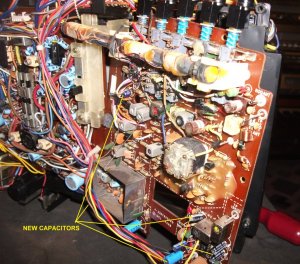Tuners are very complicated circuits. The tiny RF signal needs to be amplified and then the unwanted portions of the amplified signals are filtered out. Aging amps (transistors) and tuner alignment probably has far more affect on tuning performance than any of those electrolytic caps. It is not unusual for RF transistors to get weaker as they age. Not easy to find suitable substitute vintage transistors however. This is one application where the transistor suffix is critical. When I say suffix, most transistors are identified by a number. For example, 2SK49 is often found in the front end of a tuner. Maybe the 2SK49 can have suffix such as -G, -0, -Y (i.e. 2SK49-Y). If this transistor gets weak or fails, you will have weak or no reception. Oftentimes, people find that this transistor fails and begin to search for a replacement, go to eBay and find a 2SK49... happy days! Right? But No... that transistor didn't have a suffix designation. It most likely will not work in this application. Or maybe it wasn't an FET and was a bipolar transistor. Same situation... if the suffix designation does not match, the hFE range won't match and it either won't work or won't work well. The hFE range is important because it determines the amplification range. A weak transistor replaced with a brand new one that possess a low hFE characteristic will perform like a weak version of that transistor. There are many stages in a tuner and transistors exist in every stage. Additionally other semiconductors are equally likely to affect performance such as diodes. What I'm saying is that it's not nearly as simple as an audio circuit and while replacing the electrolytic caps can't hurt, unless they were grossly degraded or failed, they likely aren't the cause of the issues you want to fix. Also, other passive components can drift in values, such as the caps and resistors. As these are integral in the alignment circuit, if their values drift, so does the alignment. So unless you know one of the non-electrolytic caps are bad, don't mess with them. If you change them, you'll also likely change the alignment too. My suggestion is that if the tuner is important to you, then farm it out to a tuner specialist.


